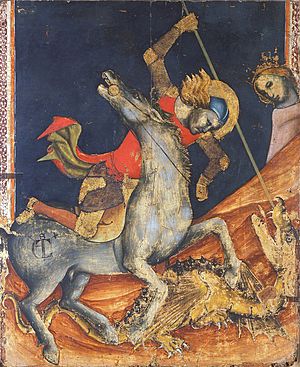Vitale da Bologna facts for kids
Vitale da Bologna (around 1309–1360) was an Italian painter from the time of the Early Renaissance. He was also known as Vitale di Aymo de' Cavalli or Vitale degli Equi. Vitale was a key artist in the 14th-century painting style of Bologna, which was his hometown and where he did most of his work.
Contents
Who Was Vitale da Bologna?
Vitale da Bologna was a talented artist who lived during the 1300s. He was part of a group of painters in Bologna who helped shape the art of their time. His paintings often showed religious scenes and figures.
Where Did Vitale da Bologna Work?
Vitale was very active in his home city of Bologna. Some of his surviving artworks in Bologna include a large altarpiece, called a polyptych, in the church of San Salvatore (painted in 1353). You can also find pieces of his wall paintings, known as frescoes, in the Santa Maria dei Servi church.
Vitale also traveled to other cities to paint:
- In Pomposa, he painted frescoes in the apse (the rounded end) of the Pomposa Abbey.
- In Ferrara, he created statues for the Ferrara Cathedral (which are now lost) and an altarpiece for a religious group, which is now in the Vatican Museums.
- In Udine, he was asked to work for a church leader named Bertrand de Saint Geniès. There, he painted frescoes in the main chapel of the Duomo and in a nearby chapel dedicated to St. Nicholas.
Vitale was last recorded in Bologna in 1359. It is believed he passed away in December of that year or early in 1360.
What Are Vitale da Bologna's Famous Paintings?
Vitale da Bologna created many important artworks. His most famous painting is a panel called St. George and the Dragon. This artwork can be seen at the Pinacoteca Nazionale di Bologna art museum.
Another well-known painting is the Madonna dei Denti (which means "Madonna of the Teeth"). This painting is signed and dated 1345 and is kept in the Davia-Bargellini Museum in Bologna.
Other works that are definitely by him include:
- A large fresco called Nativity, which was originally from the Santa Maria della Mezzaratta church. This fresco has been moved and is now also at the Pinacoteca Nazionale di Bologna.
- A fresco known as the Madonna del Ricamo (meaning "Embroidering Madonna"). This painting was originally from the San Francesco, Bologna church and is now stored at the Museo della Storia di Bologna.
Images for kids
See also
In Spanish: Vitale da Bologna para niños




